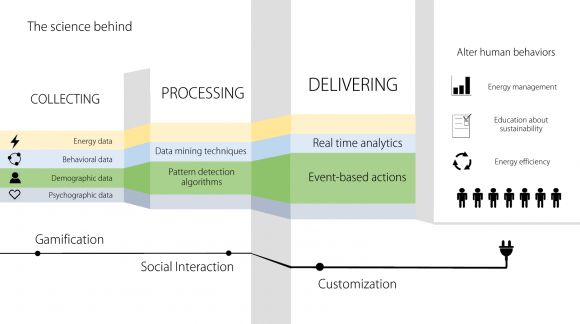Factors including regulators’ requests for higher energy efficiency, the urgent need for peak demand management, and the increased costs of customer services all suggest that utilities need to redefine their mix of products and services.
Amid changes in the energy industry, many experts predict that utilities will revamp their business models in order to maintain a strong position in the market as it evolves. Some have also highlighted the importance of engaging end users, recognizing the benefits of energy-efficient behavior in developing a consumer-centric business model for both regulated and deregulated energy markets.
Engaging end users in energy efficiency
Recent market experience shows that consumers do respond to daily or even hourly information about electricity costs to help them manage their usage. However, consumers also have many hidden needs.
These needs are either associated with individual consumer traits or are related to the external conditions that affect them. As such, utilities should investigate a wide range of needs and deploy cross-sectional solutions to satisfy the entire spectrum of customers, including individuals in lower economic tiers who often feel left out.
DiG
Intelen uses its expertise in energy management, energy and behavioral analytics, sustainable practices, and gamification techniques to effectively nudge individuals to think and act green.
Intelen's DiG is an integrated solution for energy efficiency, customer engagement, and boosting loyalty, offering data-driven marketing insights that apply to utilities. DiG is a SaaS cloud-based platform that allows user-friendly energy consumption and peak demand monitoring, disaggregation of energy consumption to the level of individual appliances, bill and peer comparison, real-time alerts on specific events, and the setting of consumption and savings goals.

DiG is also designed to easily collect energy, demographic, behavioral and psychographic data, with the ultimate goal of identifying consumers’ personal needs and delivering customized solutions with maximum value. As a result, DiG can positively influence customer engagement and increase their level of loyalty to their utility. To achieve this, DiG analyzes, combines and correlates data from many sources to identify users’ primary needs and objectives while gaining insights into how they can best be met.
DiG uses a behavioral framework to determine which motivational techniques should be used (e.g., gamification, personalization, social interaction), as well as which incentives could better work as motivational factors to achieve higher energy efficiency and lower peak demand among different consumer classes (e.g., discounts, rebates, information about environmental consequences, the opportunity to earn points, positive reinforcement, subtle feedback loops, challenges, and social effects).
DiG can also guide a utility’s marketing strategies, offering a unique data-driven perspective. As consumers interact with the service, it can increase a positive sense of connection to the utility. The software can also be used as a communication tool for crowdsourcing ideas and action. Hence, there is additional value for utilities which use DiG to implement and assess the performance of marketing campaigns, allowing them to gain meaningful insight into the initiatives' potential for success.
How DiG is different
DiG’s competitive edge is the mix of services that it offers to its customers. DiG’s human-centric design, supported by advanced analytics that manage boundless data streams, promises customized solutions that can optimize engagement, loyalty and satisfaction.
DiG’s core value comes from knowledge gained either from pure research or through field observation. Intelen has worked closely in partnership with major European and U.S. utilities and educational institutions in order to explore their own and their customers’ preferences, areas of inefficiency, and costly and complicated processes. In this way, Intelen has built a strong IP portfolio that guarantees high-quality products and services.
The DiG promise
Studies indicate that loyal customers usually account for about 20 percent of a company's clientele. These loyal customers often drive approximately 80 percent of a company's total revenues. DiG’s objective is to go beyond that percentage and reach levels of 25 percent to 27 percent for a utility’s pool of loyal customers. Another objective for DiG is to surpass the 16 percent to 20 percent in residential energy savings that competitors have achieved, as well as the 5 percent to 15 percent maximum reported response rates for most energy efficiency programs.
This article is sponsored by Intelen and does not necessarily reflect the views of Greentech Media or its editorial staff.





